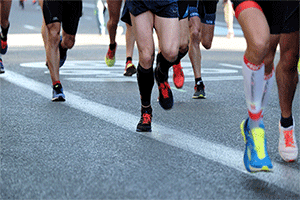Pacing can help you to clock the kilometres more effectively. Whether you’re going from couch to 5K, running a half or a full marathon this year.
Keeping to the right pace is one of the most important running skills to master. Yet many beginners head out of their front door and start pounding the pavements at peak speed, hoping a quick start will get them to the finish line earlier.
But, no matter what stage of the running journey you’re on, pacing is crucial, because it helps you to efficiently use the energy in your body and avoid running out of steam when you’re still kilometers from the final stretch.
But how can you find out your running pace, and what can you do to improve it? We asked the experts to explain…
Why is pacing so important?
“Pacing is a vital skill for runners, as it helps to improve consistency and speed, which is important if you’re training for an event, or simply trying to progress, get fitter and beat your personal best,” says Jamie Fisher of Motivate Health
“It’s so important to set a pace because it ensures you’re running at a speed where you can comfortably accumulate the kilometres ,” says Jamie, founder of (motivatehealth.co.uk). “Pace is the foundation of your running and once you’ve mastered that, you can start thinking about interval training.” If your aims are based on endurance, 80 percent of your running should be at your pace time.
It can also help you to avoid getting injured. “You can’t go flat out on every run, because you run the risk of getting injuries which might set your progress back,” says Jamie
You don’t have to be a seasoned runner to find pacing strategies useful, some who run smaller distances can benefit too. This will help them improve their performance, speed and distance.
How can you work out your training pace?
Your training pace will largely be dependent on what you are trying to achieve, it will differ if you’re really pushing yourself to improve endurance or speed, or running for fun and general fitness.
If you’re new to pacing, you need to establish your base training pace, which essentially means a pace that you can maintain and hold a conversation. This will allow you to find a pace where you are not breathless, and will help to develop your aerobic threshold
Another way to work out your training pace is by finding a running track or a flat road and then running 1km hard – not your maximum effort, but close to it, and seeing what your time is. This will help you determine what pace is good for your fitness level, and from there, you can try to increase your speed over your next training runs.
Keep a note of your times and distances, this will help you to assess if you’re improving, and give you a good understanding of what you are capable of and where you can look to improve.
Once you find your base pace, you can use that to calculate what you can expect when you increase your kilometres.
Top tips for improving your running pace over time
One of the best ways to improve your running pace is by getting to grips with your form. Keeping your upper body tall yet relaxed and swinging your arms forward and back, not side to side, at a low 90-degree angle will help to propel you forward and improve your speed.
Regular hill sessions can also help with pacing. Hill training, will increase your incline and the challenge on your calves. If you can run fast up a hill, it makes it easier to run on flat ground.
Strength training will also be a great help. If you are stronger, every running stride is easier than it would be if you were weaker. You will also consume less oxygen, which improves your running technique.
Interval work can also be beneficial, Hiit workouts will increase your fitness levels, which intern will increase your pace.
Finally, recovery is very important. Stretching, a good nights sleep and a good diet. You should eat a snack of carbohydrates and protein, or a nutritious meal within 30 minutes of finishing your run. This is where your body can best absorb the nutrients to refuel and recover.


